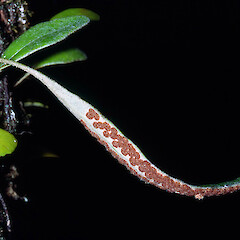Pyrrosia elaeagnifolia
Common name
leather-leaf fern, pyrrosia
Synonyms
Pyrrosia serpens sensu Allan (1961); Pyrrosia eleagnifolia (Bory) Hovenkamp orth. var.
Family
Polypodiaceae
Flora category
Vascular – Native
Endemic taxon
Yes
Endemic genus
No
Endemic family
No
Structural class
Ferns
NVS code
The National Vegetation Survey (NVS) Databank is a physical archive and electronic databank containing records of over 94,000 vegetation survey plots - including data from over 19,000 permanent plots. NVS maintains a standard set of species code abbreviations that correspond to standard scientific plant names from the Ngä Tipu o Aotearoa - New Zealand Plants database.
PYRELE
Chromosome number
2n = 74
Current conservation status
The conservation status of all known New Zealand vascular plant taxa at the rank of species and below were reassessed in 2017 using the New Zealand Threat Classification System (NZTCS) – more information about this can be found on the NZTCS website. This report includes a statistical summary and brief notes on changes since 2012 and replaces all previous NZTCS lists for vascular plants.
Please note, threat classifications are often suggested by authors when publications fall between NZTCS assessment periods – an interim threat classification status has not been assessed by the NZTCS panel.
- Conservation status of New Zealand indigenous vascular plants, 2017 . 2018. Peter J. de Lange, Jeremy R. Rolfe, John W. Barkla, Shannel P. Courtney, Paul D. Champion, Leon R. Perrie, Sarah M. Beadel, Kerry A. Ford, Ilse Breitwieser, Ines Schönberger, Rowan Hindmarsh-Walls, Peter B. Heenan and Kate Ladley. Department of Conservation. Source: NZTCS and licensed by DOC for reuse under the Creative Commons Attribution 4.0 International licence.
2017 | Not Threatened
Previous conservation statuses
2012 | Not Threatened
2009 | Not Threatened
2004 | Not Threatened
Distribution
Endemic. New Zealand: Kermadec Islands, Manawatāwhi / Three Kings Islands, North Island, South Island, Stewart Island/Rakiura, Chatham Islands.
Habitat
Coastal to montane. Common as an epiphyte on both indigenous and exotic trees and shrubs, also on rocks, cliffs faces and in urban areas on buildings, walls, bridges and fence posts.
Wetland plant indicator status rating
Information derived from the revised national wetland plant list prepared to assist councils in delineating and monitoring wetlands (Clarkson et al., 2021 Manaaki Whenua – Landcare Research Contract Report LC3975 for Hawke’s Bay Regional Council). The national plant list categorises plants by the extent to which they are found in wetlands and not ‘drylands’. The indicator status ratings are OBL (obligate wetland), FACW (facultative wetland), FAC (facultative), FACU (facultative upland), and UPL (obligate upland). If you have suggestions for the Wetland Indicator Status Rating, please contact: [Enable JavaScript to view protected content]
UPL: Obligate Upland
Rarely is a hydrophyte, almost always in uplands (non-wetlands).
Detailed description
Epiphytic or rupestral rhizomatous fern. Rhizomes long-creeping, often densely interwoven, young portions densely invested in red-brown to fawn coloured scales. Stipes reduced to phyllopodia borne in intervals along rhizome. Fronds coriaceous, fleshy to almost succulent, undivided, 30–200 × 5–20–(30) mm; adaxially yellow-green to dark green (rarely glaucescent), glabrescent, initially sparsely covered in long straight to somewhat flexuous pale-yellow to translucent caducous hairs; abaxially densely covered in fawn or white-coloured stellate hairs, aside from midrib, veins not evident on either surface;lamina variable; sterile examples broadly ovate, rhomboidal, suborbicular, to elliptic (very rarely linear); fertile linear, linear-lanceolate to suborbicular. Sori without indusia, ovoid, ellipsoid to rounded, in 2–3–(4) irregular rows (rarely more) either side of midrib and set away from frond margins. Spores yellow.
Similar taxa
None
Flowering
N.A.
Flower colours
No flowers
Fruiting
N.A.
Propagation technique
Very easily grown. Does best in dry, sunny situations. An excellent plant for rockeries, stone walls and in pots. This species often self establishes into gardens within urban areas as it is commonly found growing on the trunks of introduced trees and shrubs in urban parks, street avenues and urban indigenous forest remnants.
Etymology
pyrrosia: Flame coloured; from the Greek purros; the colour of the hairs on its leaves
elaeagnifolia: Eleagnus leaf
Attribution
Fact sheet prepared for NZPCN by P.J. de Lange 9 April 2011. Description by P.J. de Lange.
NZPCN Fact Sheet citation
Please cite as: de Lange, P.J. (Year at time of access): Pyrrosia elaeagnifolia Fact Sheet (content continuously updated). New Zealand Plant Conservation Network. https://www.nzpcn.org.nz/flora/species/pyrrosia-elaeagnifolia/ (Date website was queried)
















